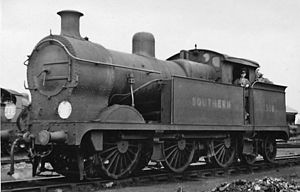SECR J class
This article relies largely or entirely on a single source. (January 2015) |
| SECR J class | |||||||||||||||||||||||||||||||||||||||||||||||||||||
|---|---|---|---|---|---|---|---|---|---|---|---|---|---|---|---|---|---|---|---|---|---|---|---|---|---|---|---|---|---|---|---|---|---|---|---|---|---|---|---|---|---|---|---|---|---|---|---|---|---|---|---|---|---|
 J class 1598 at Ashford 1946 | |||||||||||||||||||||||||||||||||||||||||||||||||||||
| |||||||||||||||||||||||||||||||||||||||||||||||||||||
| |||||||||||||||||||||||||||||||||||||||||||||||||||||
| |||||||||||||||||||||||||||||||||||||||||||||||||||||
| |||||||||||||||||||||||||||||||||||||||||||||||||||||
The SECR J class was a class of 0-6-4T steam tank locomotive built for heavy freight service on the South Eastern and Chatham Railway, by Harry Wainwright.
History
The South Eastern and Chatham Railway (SECR) had a need for versatile mixed traffic locomotives which could accelerate quickly so as not to impede the heavy passenger traffic on the densely used lines around London. Following the success of his C class 0-6-0 and his H class 0-4-4T Harry Wainwright sought to combine their good features but was limited by weight restrictions on many lines. The result was an 0-6-4 tank.[1] Five locomotives were constructed at Ashford during 1913, but Wainwright retired soon afterwards and no more were constructed. The class were moderately successful on a variety of secondary passenger and freight services. All had completed more than one million miles at the time of their withdrawal between 1949 and 1951.[2]
Numbering
The class were originally allocated unused numbers between 126 and 614. However, all but number 597 were renumbered by the Southern Railway in 1927/8 to create a unified sequence from A596 to A599. These later became 1596–1599, and then 31596–31599 under British Railways.
Locomotive Summary
| SECR No. |
SR No. |
BR No. |
Date Delivered |
Date Withdrawn |
|---|---|---|---|---|
| 129 | A596 | 31596 | October 1913 | September 1951 |
| 207 | A595 | 31595 | October 1913 | April 1951 |
| 597 | A597 | 31597 | November 1913 | October 1950 |
| 611 | A598 | 31598 | November 1913 | December 1950 |
| 614 | A598 | 31599 | December 1913 | November 1949 |
Sources
- ^ Bradley 1980, p. 45.
- ^ Bradley 1980, p. 48.
- Bradley, D. L. (1980). The locomotive history of the South Eastern and Chatham Railway. London: Railway Correspondence and Travel Society. ISBN 0-901115-49-5.
{{cite book}}: Invalid|ref=harv(help)
External links
- "SECR J Class 0-6-4T". Southern E-Group.
- "Class J Details". RailUK.
